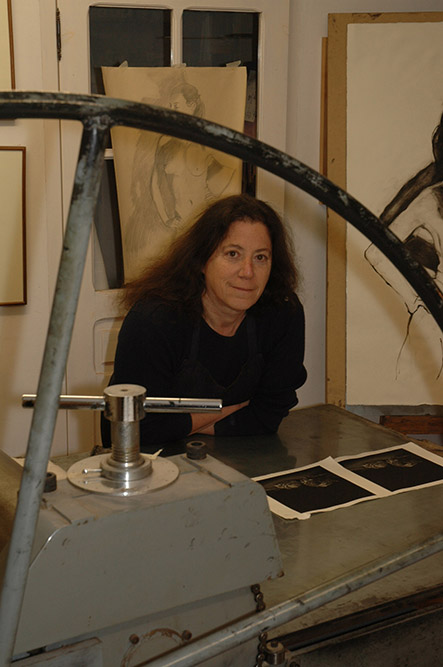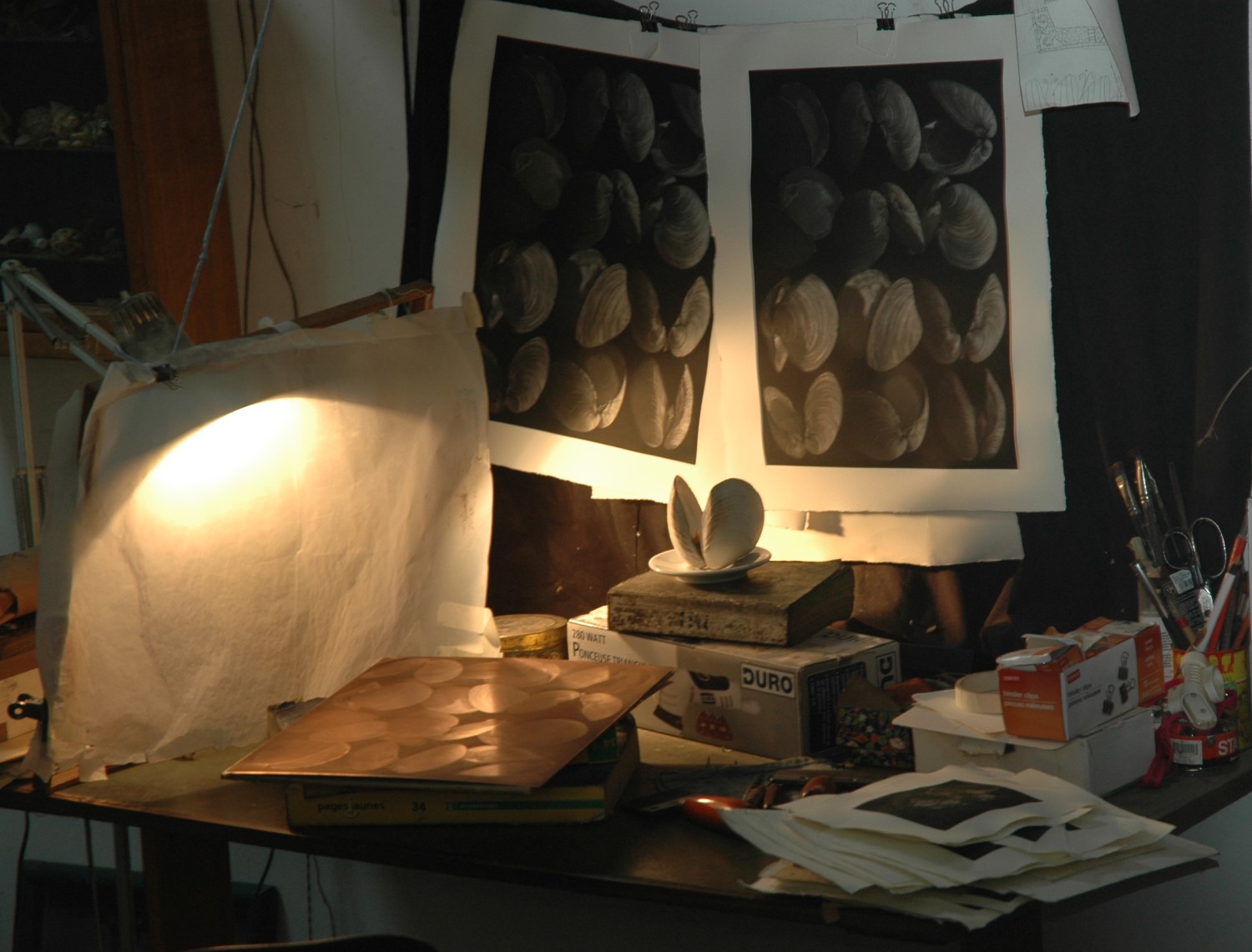Judith Rothchild and Mark Lintott
The idea of mezzotint has always interested me, as the subject of all my work is the light.
Interview with Judith Rothchild (J.R.) and Mark Lintott (M.L.), prepared by Svetlana Sapozhnikova (Emanuel von Baeyer London).

Judith and Mark, since you work together and create together, how
did you meet?
J.R.: Mark and I met in Vienna,
in German classes for foreigners in 1973 and soon after settled in the south of
France. We have always worked together as we bought a ruined house and there
was plenty to do rebuilding it. Later, we screen printed posters for ourselves
and then for other artists. Mark didn't come from the world of design, but he
was very good at laying out posters. The books started in 1997 when I learned
mezzotinting.
How and when have you started printmaking?
J.R.: I think I have always been a printmaker. I made my first linocut at age twelve, I think. When I was 13, I had a commission from friends of my parents for a two-colour print and was paid $12. That was my first sale. As a teenager, I discovered reduction linocuts. At art school, I did quite a bit of etching and lithography and learned screen printing making posters against the Vietnam war in the cellar of the dorm. When we came to France, I principally worked in pastel, but we made very elaborate editions in screenprint after my pastels in anything up to 20 colours.
Judith, why did you choose the technique of mezzotint?
J.R.: The idea of mezzotint has
always interested me as the subject of all my work is the light. However, when
I was at art school, nobody knew anything about it and I think it would have
been seriously frowned upon as being unfashionable. It took twenty-three years
after leaving school to find someone who could teach me.
How labour intensive the process of mezzotint making?
J.R.: Preparing the plate is
very long – especially the larger formats.
I use a pole rocker, so it is less painful for the wrist and elbow, but
a 30 x 40 cm plate can take over 20 hours of rocking with a 4-inch rocker. But
the good side is that when the plate is well prepared it is free sailing from
there. Many artists are attracted to
mezzotint because it is supposed to be slow and zen, but I draw very quickly and
I can work up a very complex drawing in a few days. I have a basic rule that it
takes at least five or six state proofs to advance the drawing and let the
surface of the plate mature.

Do you draw directly on the plate or you use one of your prep
drawings for inspiration, perhaps one of your pastels?
J.R.: Most of my images are
drawn directly from life on to the plate. I have a little “stage” on my
worktable so that my subject is eye height. I very rarely make preliminary
drawings, only sometimes to see if a complex image can fit on the plate. I also
use drawings from my sketchbook to make prints from our travels. I think I have only used a photo twice for
hundreds of prints but that was for a very specific subject, for example the
hidden face of the moon.
Who are your biggest
influences in this technique from the past and the present?
J.R.: I learned mezzotinting
from Albert Woda in a four-day course, so for a number of years he was a very
important influence. He also published our first book. I don't really have many “influences”, but I
have colleagues that I respect, like Mikio Watanabe. Recently, I have seen the work of Sarah
Gillespie, which I like a lot. There is a biennial International Mezzotint
Festival in Ekaterinburg, Russia, which brings together the work of one hundred
mezzotinters worldwide. There are some
very skilled printmakers out there, but it is unfortunate that there are few
whose combination of technique and image really gel for me.

Do you see if collecting habits of mezzotint works differ in
different countries?
J.R.: It is not so much a
question of collectors, but of printmakers; there are many countries where
mezzotinting is virtually unknown.
How do you work? What is your daily routine?
J.R.: There is no daily
routine. I work on my plates virtually
every day, usually after the gardening and before cooking.
M.L.: Making books is not a
full-time project, however, when I am involved, it is a seven-day-a-week job.
We had a student with us in August who was surprised to see that book making
could be so intensive.

You both are involved in creating beautiful artist’s books. How
many artist’s books have you produced so far?
J.R.: We have made about forty
editions.
How much work do you put into production of such a book?
M.L.: Too much to think about!
What are your criteria on the choice of a poet?
M.L.: We were very lucky that we
knew Ruth Rainlight because she and Alan Sillitoe had a holiday house in our
region, and she wrote a poem for Judith before we had even considered making a
book. We had the chance to meet other poets at a major festival that took place
near us. We choose texts which are visual and that speak to us. Recently, we
published a poem in Portuguese as we discovered that Portuguese, like English
language, poetry can be very direct and visual. We also use classical texts
when they seem particularly appropriate. For French texts it is better that
they be out of copyright because certain publishers are very tricky. Dealing
with American and English publishers is definitely easier.
What are the steps
between an idea and a finished book?
M.L.: As it is an enormous
amount of time and energy, first we both have to be in agreement! Sometimes,
Judith has made a series of prints and she hopes I might want to make a book,
sometimes, we meet a poet we want to work with, sometimes I find a text that
inspires me. Before a project can
develop, we need to agree to a format and decide how many images it might have
and what techniques we may use. Judith usually completes the images before I
get more involved. Then I need to choose type size, the quantity of pages
etc. Although she might make
suggestions, I am responsible for the final layout. The balance between text
and image is essential in an artist's book. We always print the mezzotints
before the text. For the letterpress, I have a choice between four presses, a
couple dating back to the 19th century and well over a hundred cases of lead
type. Each press has its own advantages and limitations. The Vandercook is excellent but is limited in
format and thickness of paper. The Adana is a wonderful little machine, but the
format is very restricted. The Stanhope and the Albion are very flexible but
more difficult to set up and slow to print. When all is printed, I have the
challenge of the covers, slipcases and boxes. The fact of doing everything
ourselves gives us infinite options of making the project more
complicated. We often decorate the
papers ourselves using linocut, screenprinting, marbling or embossements. As we
live in the country, it is important to have stocks of many papers available,
as local supplies are limited.
How has your practice change over the years if it did?
M.L.: What is important for us
is that every book has a new challenge, something we have never done before. As
a result, we are always learning new tricks to be incorporated in the next
book. Our first books, we printed up to 50 copies. Now our editions are much
smaller, but the books are often more complicated.
What an ideal artist’s book should contain?
M.L.: Content! Not just an intellectual
idea.
Do you have a favourite
artist’s book which triggered your interest in producing one of your own?
J.R.: Not really.
What is your next project?
M.L.: We are just finally
finishing a project that we started during the lockdown last spring – a little
fragment of the “Peste” by Camus with Judith's linocuts of 22 rats running to
their death. On Christmas day, we are
looking forward to a new challenge – a mini book made in one day in, perhaps,
10 copies, if we succeed.
